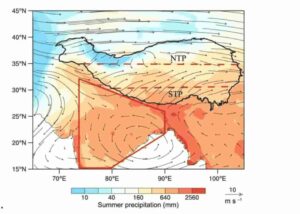
Black carbon aerosol is the product of incomplete combustion of fossil fuels and biomass, and has strong light absorption. Black carbon deposition in snow ice reduces the albedo of the snow ice surface, accelerating the melting of glaciers and snow cover, and thus changing the hydrological process and water resources in the region.
The South Asia region adjacent to the Tibetan Plateau is one of the regions with high black carbon emission in the world. Black carbon aerosol from South Asia can transport across the Himalayan Mountains to the inland region of the Tibetan Plateau.
Recently, a joint research team led by Prof. Kang Shichang from the Northwest Institute of Eco-Environment and Resources of the Chinese Academy of Sciences (CAS), Prof. Chen Deliang from the University of Gothenburg and Prof. Robert Gillies from the Utah State University analyzed the influence of black carbon aerosols on regional precipitation and glaciers over the Qinghai-Tibet Plateau.
Their findings were published in Nature Communications on Nov. 30.
The researchers found that since the 21st century, the South Asian black carbon aerosols have indirectly affected the material supply of the Tibetan Plateau glaciers by changing water vapor transport in the South Asian monsoon.
“Black carbon aerosols in South Asia heat up the middle and upper atmosphere, thus increasing the north-south temperature gradient,” said Prof. Kang. “Accordingly, the convective activity in South Asia is enhanced, which causes convergence of water vapor in South Asia. Meanwhile, black carbon also increases the number of cloud condensation nuclei in the atmosphere.”
These changes in meteorological conditions caused by black carbon aerosols make more water vapor form precipitation in South Asia, and less water vapor transmit to the Tibetan Plateau. As a result, precipitation in the central and southern Tibetan Plateau decreases during monsoon, especially in the southern part of the Tibetan Plateau.
The decrease of precipitation further leads to the decrease of material supply of glaciers. From 2007 to 2016, the reduced material supply accounted for 11.0% of the average glacier material loss on the Tibetan Plateau and 22.1% in the southern part of the plateau.
“The transboundary transport and deposition of black carbon aerosols in South Asia accelerate glacier ablation on the Tibetan Plateau. Meanwhile, the reduction of plateau summer precipitation will reduce the material supply of plateau glacier, which will increase the amount of glacier material deficit,” said Prof. Kang.
Reference:
Junhua Yang et al, South Asian black carbon is threatening the water sustainability of the Asian Water Tower, Nature Communications (2022). DOI: 10.1038/s41467-022-35128-1
Note: The above post is reprinted from materials provided by Chinese Academy of Sciences.










